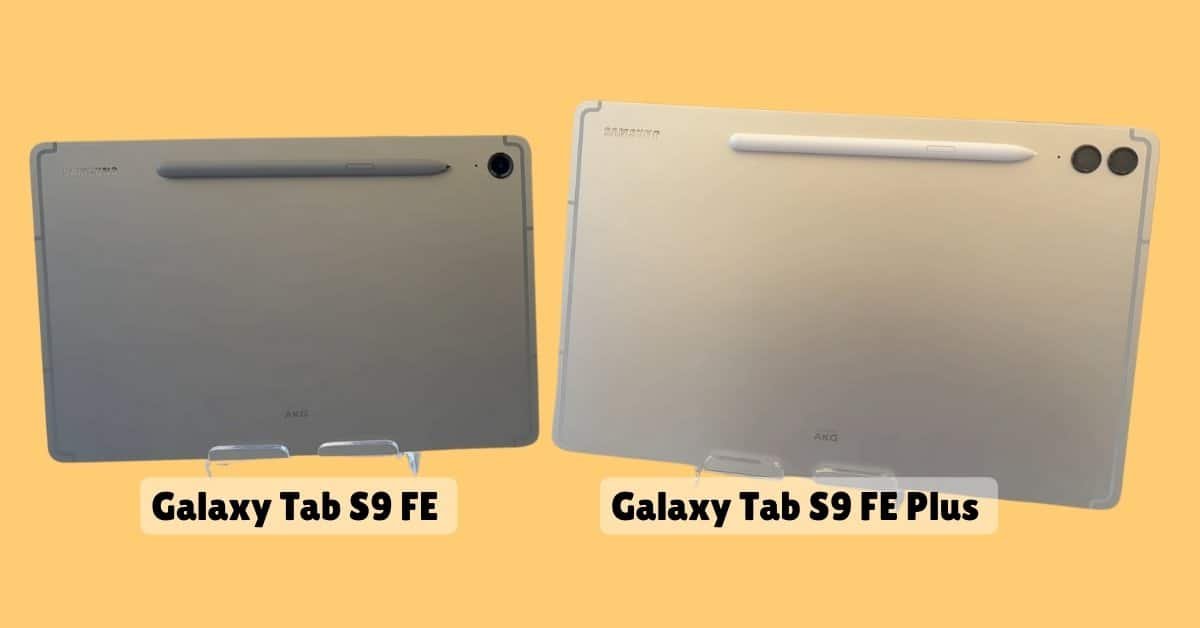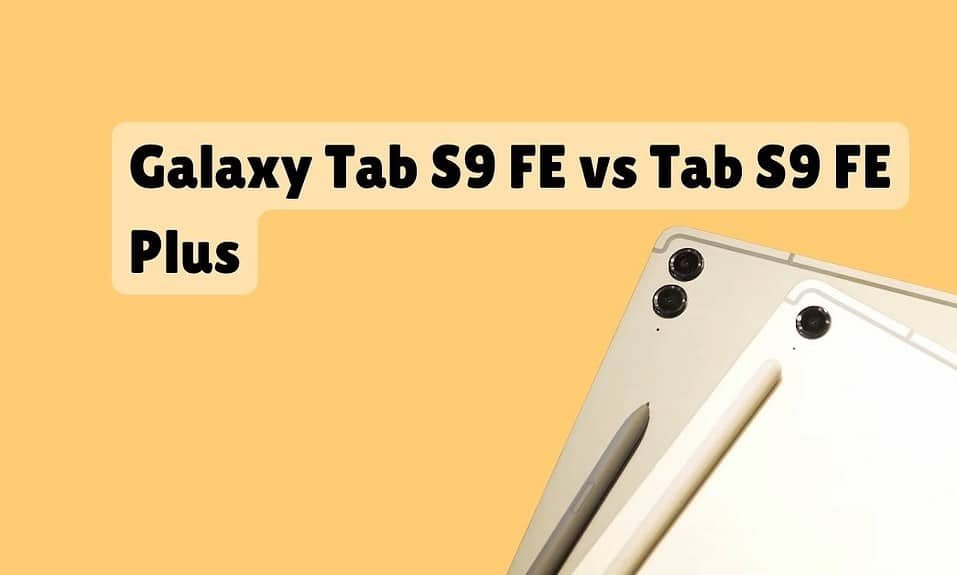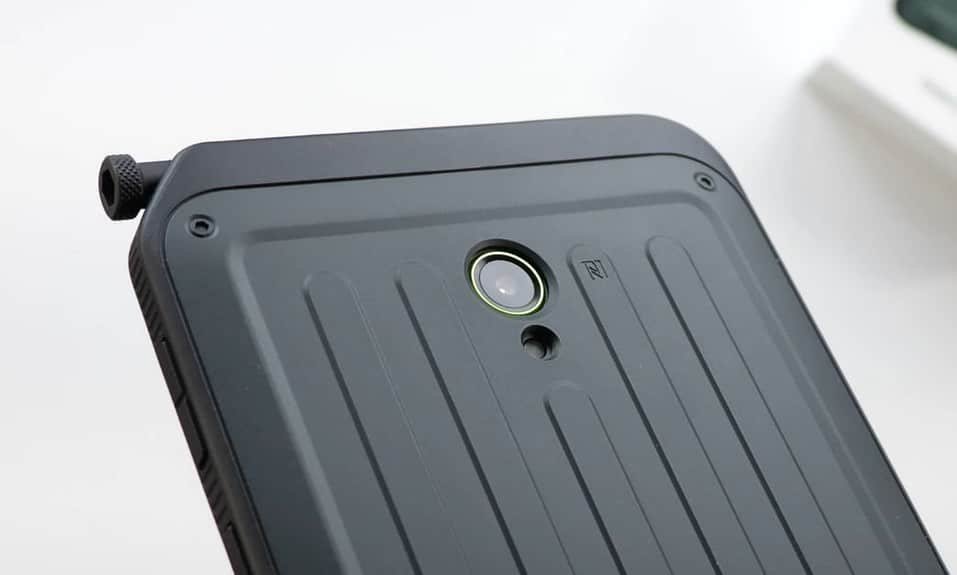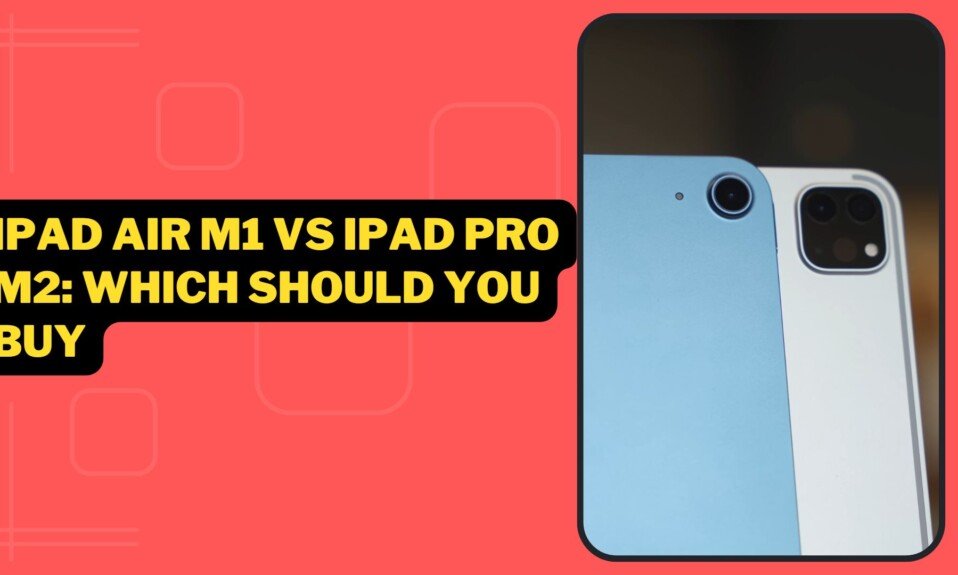Samsung Galaxy Tab S9 FE vs Tab S9 FE Plus: Today, we’re diving into a fun and informative review of Samsung’s latest mid-range tablets: Samsung Galaxy Tab S9 FE vs Tab S9 FE Plus.
These tablets are part of Samsung mid-range lineup but come with a premium price tag. Despite some minor differences in terms of camera, battery capacity, and RAM, these tablets are nearly identical in terms of design and performance.
Table of Contents
Specifications
| Galaxy Tab S9 FE | Galaxy Tab S9 FE+ | |
|---|---|---|
| Price | From $399 | From $521 |
| Brand | Samsung | Samsung |
| Dimensions | 165.8 x 254.3 x 6.5mm | 285.4 x 185.4 x 6.5mm |
| Storage | 128GB/256GB | 128GB/256GB |
| Expandable | Up to 1TB | Up to 1TB |
| OS | Android 13, One UI 5.1.1 | Android 13, One UI 5.1.1 |
| Battery | 8,000mAh | 10,090mAh |
| Ports | USB-C | USB-C |
| Display | 10.9″ IPS LCD, 90Hz | 12.4″ IPS LCD, 90Hz |
| Resolution | 2304 x 1440 | 2560 x 1600 |
| Processor | Samsung Exynos 1380 | Samsung Exynos 1380 |
| Colors | Gray, Mint, Silver, Lavender | Gray, Silver, Mint, Lavender |
| IP Rating | IP68 | IP68 |
| Weight | 523g (Wi-Fi), 524g (5G) | 628g |
| Charge Options | 45W wired, USB-C | 45W wired, USB-C |
| SIM Support | Yes | No |
| Cellular Connectivity | 5G (optional) | No |
| Wi-Fi Connectivity | Wi-Fi 6 | Wi-Fi 6 |
| Bluetooth | Bluetooth 5.3 | Bluetooth 5.3 |
| Stylus | S Pen included | S Pen included |
| RAM | 6GB/8GB | 8GB/12GB |
| Front Camera | 12MP ultrawide | 12MP ultrawide |
| Rear Camera | 8MP main | 8MP main; 8MP ultrawide |
| Charging Speed | 45W wired | 45W wired |
Design, Build Quality, and Size
When it comes to design, build quality, and size, both the Tab S9 FE and Tab S9 FE Plus excel in these areas. They feature a high-quality aluminum unibody design that is not only visually appealing but also feels premium in hand. The tablets are slim and lightweight, making them easy to carry around.

In terms of size, the Tab S9 FE and Tab S9 FE Plus are nearly identical, with only minor differences. The Tab S9 FE Plus is slightly larger and heavier, which may be a factor to consider depending on personal preferences.
When comparing them to the Tab S9 series, the FE models may not have as thin bezels or as slim a profile, but the differences are subtle and not immediately noticeable. Overall, the design and build quality of both tablets are impressive.
One notable feature of both tablets is the placement of the fingerprint sensor, which is integrated into the power button. While convenient, some users may find the position less than ideal, especially when using the tablet in landscape mode.
Audio quality and speaker performance are also noteworthy. Both tablets feature stereo speakers that deliver excellent sound. While they may not match the audio quality of the Tab S9 series, they still provide a satisfying listening experience.
Another advantage of the Tab S9 FE and Tab S9 FE Plus is their IP68 water and dust resistance. This makes them suitable for use in various environments, providing peace of mind for users concerned about accidental spills or exposure to dust.
However, it’s important to note that both tablets have USB-C 2.0 ports, which have certain limitations. For example, they may not support certain high-speed data transfer or display output capabilities that USB-C 3.0 or Thunderbolt ports offer.
Display and Screen Technology
When comparing the Samsung Galaxy Tab S9 FE and Tab S9 FE Plus, one important aspect to consider is the display and screen technology used in these tablets.
Firstly, let’s discuss the difference between LCD displays and OLED displays. LCD displays use a backlight to illuminate the pixels, while OLED displays have individual pixels that emit light. This fundamental difference affects various aspects of the display quality.
In terms of quality and resolution, both the Tab S9 FE and Tab S9 FE Plus feature LCD panels. While LCD displays may not offer the same deep blacks and vibrant colors as OLED displays, they still provide a satisfactory visual experience. The resolution is adequate, and the color reproduction is decent, although not as intense as OLED.
Brightness levels and outdoor visibility are crucial factors when choosing a tablet. Both tablets offer impressive brightness levels, with the Tab S9 FE reaching around 650 nits and the Tab S9 FE Plus going up to approximately 750 nits. This means that you won’t have any issues with readability, even in bright sunlight.
One notable difference between these tablets and the Tab S9 series is the lack of lamination. The Tab S9 FE and Tab S9 FE Plus do not have a laminated display, which may impact the user experience. Laminated displays eliminate the gap between the glass and the actual display, resulting in a more immersive and responsive touch experience. However, the absence of lamination in these tablets is not immediately noticeable and does not significantly affect everyday use.
Another aspect worth mentioning is the 90Hz refresh rate. While some may argue that a 120Hz refresh rate would have been preferable, the 90Hz refresh rate still offers a smoother scrolling and animation experience compared to the standard 60Hz refresh rate found in many other tablets in this price range. It enhances the overall fluidity of the user interface and makes interactions more enjoyable.
Performance and Processing Power
Now, let’s discuss the performance and processing power of the Samsung Galaxy Tab S9 FE and Tab S9 FE Plus. Unfortunately, this is where both tablets fall short, primarily due to the use of the Exynos 1380 octa-core processor.
One major critique of this processor is its underwhelming performance, which results in noticeable lags and stutters during daily usage. Tasks such as swiping to access the Google Newsfeed or opening and closing apps can be frustratingly slow. In comparison to the Tab S9 series, the FE models do not match up in terms of speed and responsiveness.
Gaming performance is also affected by the limitations of the Exynos 1380 processor. While you can still play games on these tablets, you may have to lower the graphics settings to ensure smooth gameplay. The additional 2GB of RAM in the FE Plus model does not provide a significant improvement in gaming performance.
Many users expected a more suitable processor for the price range of these tablets, especially considering their mid-range positioning. The Exynos 1380 falls short of delivering the performance expected at this price point.
Another concern regarding the performance is the impact on future software updates. While Samsung promises four major Android version updates and five years of security updates, it is uncertain whether these tablets will be able to handle the future software demands. Given the underpowered processor, it is reasonable to be skeptical about the tablets’ ability to run smoothly with future updates.
Software Features and Updates
Now let’s talk about the software features and updates of the Samsung Galaxy Tab S9 FE and Tab S9 FE Plus. These tablets come with Android 13 out of the box, and an update to Android 14 is expected in the near future.
One standout feature is Samsung’s track record when it comes to security patch updates. While the current security patch level may not be the most up-to-date, Samsung has a reputation for providing regular security updates to its devices, ensuring that users’ data and information remain protected.
Another aspect worth appreciating is Samsung’s software customization. The One UI 5.1 interface offers a user-friendly experience with a variety of customization options. Users can personalize their tablet’s settings, themes, and app layouts to suit their preferences.
One of the benefits of these tablets is the included S Pen. Samsung’s stylus functionality is well-integrated into the software, allowing for precise and intuitive usage. The S Pen opens up possibilities for note-taking, drawing, and creative expression, making it a valuable tool for students, artists, and professionals.
When compared to other Android tablet manufacturers, Samsung stands out with its comprehensive software features. While some competitors may offer similar hardware specifications, Samsung’s software optimizations and stylus integration give it an edge in terms of productivity and usability.
However, it’s important to acknowledge some concerns regarding app quality. While Samsung provides a wide range of pre-installed apps and access to the Google Play Store, the overall quality and optimization of third-party apps may vary. Some users have reported issues with certain apps not being fully optimized for tablets or experiencing occasional glitches.
Camera Performance
When it comes to camera performance, the Samsung Galaxy Tab S9 FE and Tab S9 FE Plus offer functional front and rear cameras. The 12-megapixel front camera is suitable for video calls and provides satisfactory image quality. It supports 4K video recording, allowing for clear and detailed video chats.
The 8-megapixel rear camera is primarily designed for document scanning. While it may not offer advanced photography features or exceptional image quality, it serves its purpose well for capturing documents and other similar tasks.
It’s important to note that these tablets are not meant to be used as professional cameras. The camera capabilities are sufficient for basic photography needs but may not meet the expectations of users looking for advanced camera features or exceptional image quality.
One notable difference between the Tab S9 FE and Tab S9 FE Plus is the inclusion of a wide-angle camera in the Plus model. This additional camera allows for a wider field of view, which can be useful for capturing landscapes or group photos.
Overall, the camera performance of the Tab S9 FE and Tab S9 FE Plus is decent for everyday usage, such as video calls and document scanning. However, users should not expect advanced camera features or top-notch image quality.
Battery Life and Charging
When it comes to battery life and charging, the Samsung Galaxy Tab S9 FE and Tab S9 FE Plus offer satisfactory performance, but there are a few considerations to keep in mind.
First, let’s discuss battery expectations and real-life performance. Both tablets come with decent-sized batteries, with the Tab S9 FE featuring an 8,000mAh battery and the Tab S9 FE Plus sporting a larger 10,090mAh battery. In real-life usage, you can expect the tablets to last for about two days with moderate usage, including web browsing, media playback, and note-taking. However, heavy usage, such as gaming or video streaming, may drain the battery faster.
Usage patterns and screen-on time also play a crucial role in battery performance. Keeping the screen brightness at moderate levels and reducing background app activity can help extend battery life. Additionally, enabling power-saving mode or optimizing battery usage in the device settings can further improve battery efficiency.
When comparing battery life with other tablets, it’s important to consider the usage scenario and specific tasks. While the Tab S9 FE and Tab S9 FE Plus may not have the longest battery life compared to some other tablets on the market, they still offer satisfactory performance for everyday use.
Charging speed and limitations are also factors to consider. Both tablets support fast charging, but the charging speed may vary depending on the charger used. It’s important to note that the tablets come with USB-C 2.0 ports, which have certain limitations compared to USB-C 3.0 or Thunderbolt ports. This means that they may not support certain high-speed data transfer or display output capabilities.
Conclusion!
In conclusion, the Samsung Galaxy Tab S9 FE and Tab S9 FE Plus offer a mixed bag of positive aspects and drawbacks. Let’s recap the key points discussed in this comparison.
Recap of positive aspects and highlights:
- The design, build quality, and size of both tablets are impressive, featuring a high-quality aluminum unibody design that feels premium in hand.
- The display quality is satisfactory, with LCD panels offering good resolution and decent color reproduction.
- The tablets have excellent brightness levels, making them readable even in bright sunlight.
- The software features and updates are commendable, with Samsung’s One UI 5.1 offering a user-friendly experience and seamless stylus integration.
- The tablets come with an included S Pen, providing precise and intuitive usage for note-taking, drawing, and creative expression.
- The battery life and charging performance are satisfactory, with moderate usage lasting for about two days.
Emphasis on the major drawbacks:
- The performance and processing power are disappointing, primarily due to the underwhelming Exynos 1380 octa-core processor, resulting in noticeable lags and slower responsiveness.
- Gaming performance is compromised, requiring lower graphics settings to ensure smooth gameplay.
- There are concerns about future software updates and the tablets’ ability to handle the demands of future updates, given the underpowered processor.
Price considerations:
Price is a significant factor to consider when deciding between the Tab S9 FE and Tab S9 FE Plus. The tablets have premium price tags that may not align with the performance and features they offer.
It is hoped that the prices of these tablets will decrease further, making them a more attractive option for buyers. Monitoring price trends and waiting for discounts may be beneficial for those interested in these devices.
Ultimately, the choice between the Tab S9 FE and Tab S9 FE Plus depends on individual needs and expectations. If a larger display is a priority, the Tab S9 FE Plus may be suitable, despite its drawbacks. However, the Tab S9 FE offers a more cost-effective option with similar features.
Overall, the Samsung Galaxy Tab S9 FE and Tab S9 FE Plus have their strengths and weaknesses. It is essential to consider the positive aspects, such as the design, display quality, software features, and battery life. However, the major drawbacks, including the underwhelming performance and higher price tags, cannot be ignored.




